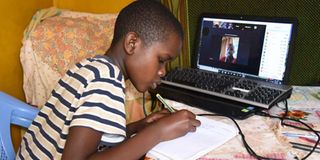Why school transition is evident myth

Josiah Victor Alubala, a Class Six pupil at Potters House Academy in Eldoret attends a virtual lesson on May 29, 2020.
What you need to know:
- The fragile nature of our overly dependent school system has been found wanting.
- Many students are struggling with the overambitious curriculum.
Never in the modern education era have schools undergone massive closures like since March, following the Covid-19 outbreak.
Education has been singled out as bear the longest-lasting impact of the pandemic. The fragile nature of our overly dependent school system has been found wanting.
The calls for education reform to match the increasing demands of modern learning seem to have got little traction. Obviously, Covid-19 has reminded states and societies of the complacency in adjusting to this elastic demand.
Watching as the little that children had got in school evaporates daily must remind us of our malignance in failing to confront the systemic problems in our design, packaging and delivery of education.
The devastating psychological effects of forced repetition for all classes and the spiral economic impact on the sector aside, at the heart of this conversation should be sheer recognition that Covid-19 was never an education crisis at first; education became one of the heavy casualties due to its fragility.
The war against an invisible enemy should be at the centre of our debate and healthy conversation on reopening schools and the elephant in the room around transition.
Emerging as from war
Transition is not a moral but logical issue. And with a system emerging as from war, reopening cannot happen in the context of the ‘old normal’. Many students are struggling with the overambitious curriculum and those whom we shall receive in school next year will require palliative education care due to massive learning losses.
Technically, 2021 will be the most abnormal year: We will need to neither go back nor go forward but rather ensure some sense of stability. The onus now lies with the education planners to design the ‘education in recovery phase.’
That is what we need to debate.





